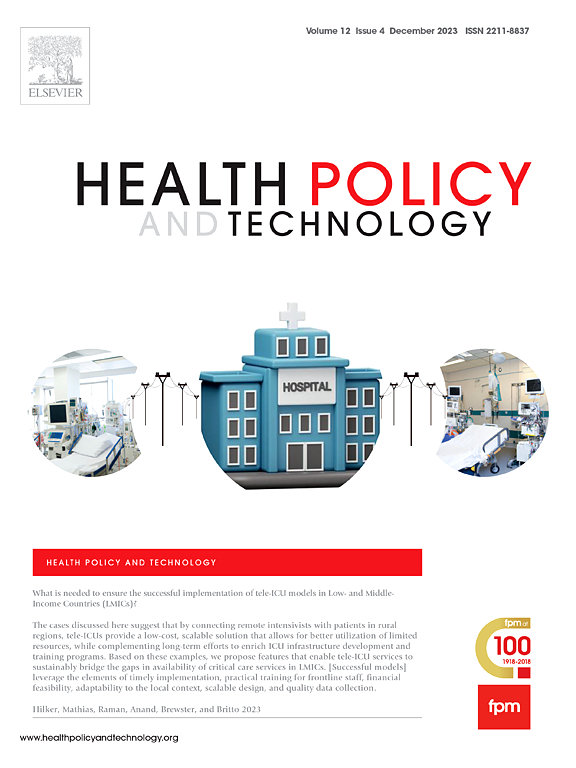基于WHO综合评价模型的中国中医院卫生资源与服务利用评价
IF 3.7
3区 医学
Q1 HEALTH POLICY & SERVICES
引用次数: 0
摘要
背景:作为基本卫生保健服务的一部分,中医药可有助于实现全民健康覆盖。本研究旨在评估2002 - 2021年中国中医医院卫生资源与服务利用情况。方法采用横断面研究方法,分析2002 - 2021年中国中医医院的物理资源(医院和床位)、人力资源(执业医师、执业(助理)医师和中医药师)、服务利用(门急诊访问量、住院和出院患者)、床位利用和健康需求等相关数据。中医医院资源和服务利用数据摘自《中国中医药统计年鉴》。甲类和乙类法定传染病发病率数据来源于国家疾病预防控制局,母婴死亡率数据来源于《中国卫生统计年鉴》。采用世界卫生组织的综合评价模型和秩和比(RSR)法对2002 - 2021年中医医院提供的服务进行排序和分类。结果中国中医医院、床位和执业医师数量逐年增长,但所占比例不高,2021年分别为15.63%、16.15%和16.73%。中医医院门诊人次、急诊人次、出院人次、住院人次分别从2007年的253,007万人次、1597.6万人次、816.3万人次、820.5万人次增加到2021年的611,61.5万人次、53,79.5万人次、31,51.9万人次、31,620万人次。自2015年以来,中医医院的床位入住率一直低于85%,随着时间的推移逐渐下降。2007年至2021年期间,资源和卫生需求的RSR值持续增长,在2021年达到0.95以上。世卫组织综合评价模型显示,2020年和2021年,中医医院的卫生需求和资源较高,但服务利用率中等。结论中国中医医院卫生资源和服务利用呈滚雪球式增长,但占比较低。与此同时,中医医院的医疗保健服务尚未得到充分利用。未来,中国应加强中医药医疗服务的提供和利用,提高中医医院医疗服务的使用率。本文章由计算机程序翻译,如有差异,请以英文原文为准。
Evaluation of health resources and service utilization in traditional Chinese medicine hospitals in China based on WHO's comprehensive evaluation model
Background
Traditional Chinese medicine (TCM) could contribute to achieving universal health coverage as part of essential healthcare services. This study aimed to evaluate the health resources and services utilization of TCM hospitals in China from 2002 to 2021.
Methods
This cross-sectional study analyzed data related to physical resources (hospitals, and beds), human resources (practitioners, licensed (assistant) TCM doctors, and TCM pharmacists), services utilization (outpatient and emergency visits, admission and discharged patients), bed utilization, and health needs of TCM hospitals in China from 2002 to 2021. Data of TCM hospital resources and services utilization were extracted from the China Statistical Yearbooks of Chinese Medicine. The incidence of Class A and B data notifiable infectious diseases were sourced from the National Bureau of Disease Prevention and Control, while maternal and infant mortality rates were obtained from the China Health Statistical Yearbooks. WHO's comprehensive evaluation model and the Rank Sum Ratio (RSR) method were used to rank, and categorize the services provided by TCM hospitals from 2002 to 2021.
Results
The number of TCM hospitals, beds, and practitioners in China grew annually, but their proportion was modest, at 15.63 %, 16.15 %, and 16.73 % in 2021. The number of outpatient visits, emergency visits, discharged patients, and admissions in TCM hospitals increased from 253,007 thousand, 15,976 thousand, 8,163 thousand, and 8,205 thousand visits in 2007 to 611,615 thousand, 53,795 thousand, 31,519 thousand, and 31,620 thousand visits in 2021, respectively. The bed occupancy rate in TCM hospitals has been consistently below 85 % since 2015, showing a gradual decrease over time. Between 2007 and 2021, the RSR values for resources and health needs showed continuous growth, reaching over 0.95 in 2021. WHO's comprehensive evaluation model indicated that TCM hospitals experienced high health needs and resources but medium services utilization in 2020 and 2021.
Conclusions
Health resources and services utilization of TCM hospitals in China have snowballed, but their share has remained low. Meanwhile, the healthcare services in TCM hospitals have been underutilized. In the future, China should strengthen the provision and utilization of TCM medical services, and improve the utilization rate of healthcare services in TCM hospitals.
求助全文
通过发布文献求助,成功后即可免费获取论文全文。
去求助
来源期刊

Health Policy and Technology
Medicine-Health Policy
CiteScore
9.20
自引率
3.30%
发文量
78
审稿时长
88 days
期刊介绍:
Health Policy and Technology (HPT), is the official journal of the Fellowship of Postgraduate Medicine (FPM), a cross-disciplinary journal, which focuses on past, present and future health policy and the role of technology in clinical and non-clinical national and international health environments.
HPT provides a further excellent way for the FPM to continue to make important national and international contributions to development of policy and practice within medicine and related disciplines. The aim of HPT is to publish relevant, timely and accessible articles and commentaries to support policy-makers, health professionals, health technology providers, patient groups and academia interested in health policy and technology.
Topics covered by HPT will include:
- Health technology, including drug discovery, diagnostics, medicines, devices, therapeutic delivery and eHealth systems
- Cross-national comparisons on health policy using evidence-based approaches
- National studies on health policy to determine the outcomes of technology-driven initiatives
- Cross-border eHealth including health tourism
- The digital divide in mobility, access and affordability of healthcare
- Health technology assessment (HTA) methods and tools for evaluating the effectiveness of clinical and non-clinical health technologies
- Health and eHealth indicators and benchmarks (measure/metrics) for understanding the adoption and diffusion of health technologies
- Health and eHealth models and frameworks to support policy-makers and other stakeholders in decision-making
- Stakeholder engagement with health technologies (clinical and patient/citizen buy-in)
- Regulation and health economics
 求助内容:
求助内容: 应助结果提醒方式:
应助结果提醒方式:


